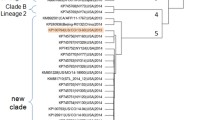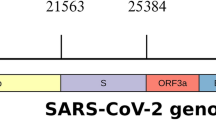Summary.
Genomic characterization of Norwalk-like human caliciviruses (NLVs) originating from outbreaks and sporadic cases of acute gastroenteritis has revealed surprisingly high levels of diversity, even in the RNA polymerase gene, which is anticipated to be highly conserved. Since information on antigenic relationship is limited, due to the lack of a tissue culture system for these viruses, strains mostly are described on the basis of their genetic relatedness. However, the lack of uniformly applied criteria has led to a confusing array of strains with different groups employing different names for similar genetic lineages. Our goal was to conduct a structured analysis of genomic relationships among NLV strains in an attempt to provide an interim framework for genotyping. We assembled a panel of 31 potentially distinct genogroup I (GGI) and genogroup II (GGII) NLVs that reflected the diversity seen in strains detected by our laboratories and in published sequences. Phylogenetic analysis of sequences from regions of the open reading frames (ORF) 1, 2 and 3 was performed in order to investigate genomic relationships. The strains sequenced fell into seven phylogenetic groups in GGI and at least five phylogenetic groups in GGII, based on greater than 80% nucleotide identity in the region of ORF2 encoding the N-terminus of the capsid protein, and consistent clustering with high bootstrap values irrespective of the method used. Analysis of the ORF1 and ORF3 regions supported for most strains the clustering as established for those derived from ORF2. In the ORF1 region, used by most laboratories for diagnostic RT-PCR, clustering was consistent when a putative genotype border was set at 15% nucleotide mismatches for viruses in GGI and at 10% for viruses in GGII. Two strains grouped within different clusters based on ORF1 and ORF2 indicating that recombination may have occurred. We discuss the implications of these observations for the classification and typing of NLVs.
Similar content being viewed by others
Author information
Authors and Affiliations
Additional information
Accepted September 9, 1999/Received February 24, 1999
Rights and permissions
About this article
Cite this article
Vinjé, J., Green, J., Lewis, D. et al. Genetic polymorphism across regions of the three open reading frames of “Norwalk-like viruses”. Arch. Virol. 145, 223–241 (2000). https://doi.org/10.1007/s007050050020
Issue Date:
DOI: https://doi.org/10.1007/s007050050020




